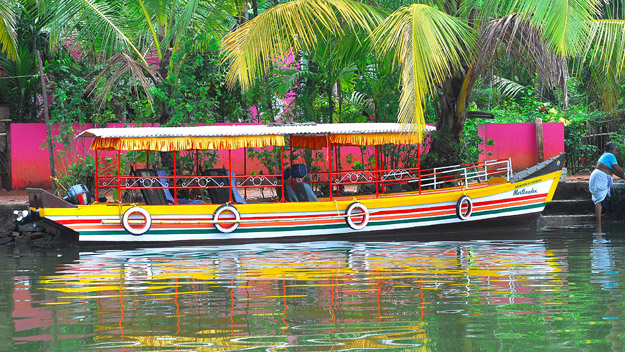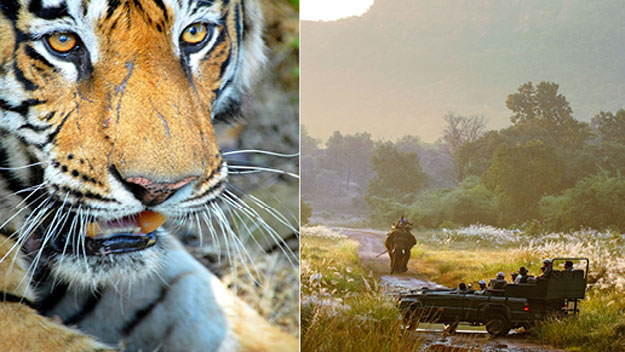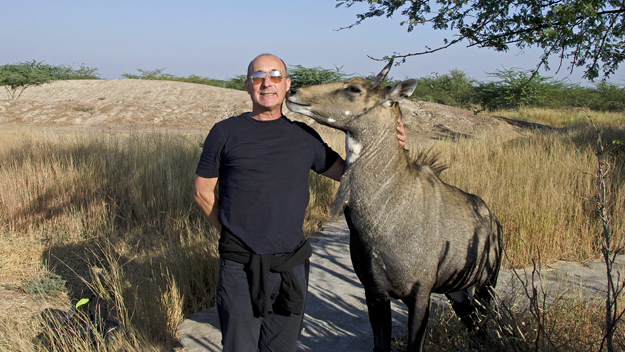So this is what it feels like being a maharaja. I’m sitting on a larger-than-life wicker chair in the shape of a peacock’s tail at the prow of a stately kettuvallam on the Backwaters of Kerala. Men are swimming with the agility of dolphins in the water, catching prized fish called karimeen, with their bare hands. They laugh, while treading water, and wave the fish in their grasp in greeting.
A fragrant five-course lunch is being prepared in the galley and a light breeze is fanning me as effectively as a punkah wallah. Here, on Vembanad Lake, the high humidity and 32°C heat feels pleasant enough. On land, the air is hot and soupy.
“Would, sir, like a drink of coconut milk with a twist of lime,” asks a deck hand, dressed in a traditional dhoti, a rectangular cloth wrapped around the waist and tied in a knot. “Why not,” I reply, as he hands me the drink with a beaming smile, his broken teeth stained red from chewing betel nut. The juice is served chilled in half a coconut shell and is deeply refreshing.
Before boarding our kettuvallam (converted spice barge), I have an Ayurvedic treatment – a two-hour, four-handed massage, known as elakki thirummu, based on the deep-tissue therapy used to treat Keralan martial artists. It’s very thorough and a little challenging, but as I walk from the spa to the pier, I feel I am floating inches above the path. This sensation continues as the boat glides towards a palm-fringed shore, where a more intimate network of canals takes us into the heart of the Backwaters.
So mesmerising are the scenes we pass, my mind slips into gentle reflection. Kerala is the India you dream of, without the dirt or the eye-popping poverty, and with so much natural beauty that the signposts all claim it, more than fairly, to be “God’s own country”. Put another way, it’s India for beginners – those in search of the exotic without all the challenges.
As the wealthiest region on the sub-continent, it is a place where disease and poverty are said to have been conquered and where every child, female as well as male, is educated. Evidence of this last point is everywhere. There are schools in almost every town, and spilling out of each are droves of immaculately uniformed children.
Even in the Backwaters, where lush tropical vegetation of palm, coconut and banana trees fringe the waterways, there are scores of school children, marching along the canal banks laughing or sitting more meekly with their parents on the ferries that coast along from village to village.
As for the women, they wear saris of colours so brilliant it doesn’t seem possible they could be washed in the canals, but everywhere you go you catch glimpses of women bashing brightly coloured garments on rocks surrounded by shady pockets of luminescent greenery. Because of the sheer elegance of the sari, Kerala’s women seem as if they are permanently in their Sunday best, even when tending animals or going to market. Their colours light up an already dazzling landscape.
My reverie is broken by the chef, Venu, who has produced a feast: fried fish (the karimeen we saw being caught earlier), bitter gourd, green mango raita; a salad of cabbage, grated coconut and mustard seeds, sambar, spicy chicken curry and twice-cooked Keralan rice.
It’s difficult to focus on this meal, as delicious as it is, with such a fascinating landscape slipping by. Families are weaving their way along the canal banks, spires of brightly painted churches rise above the palm fronds, cattle graze on grassy banks in flooded paddy fields and occasionally the boat slips under an elegantly arched pedestrian bridge, where passers-by pause and wave.
According to the kettuvallam captain, Benji, there are more than 1700 licensed houseboats in the Backwaters and whereas we are on a day tour, many visitors spend days exploring this watery wonderland, sleeping in air-conditioned rooms with queen-sized beds and ensuite bathrooms.
Time slips by quickly on the Backwaters and before sunset we are back at Coconut Lagoon, a heritage eco-resort, with its own canals, bridges and lush flower gardens. Its distinctive wooden bungalows are restored tharavads, traditional houses, each with a courtyard bathroom open to the sky. Some come with miniature Keralan vechur cows, tethered to palm trees outside, where they dutifully mow the surrounding lawn.
The resort grounds are sensational. Everywhere you look, there are chill-red and tumeric-yellow hibiscus flowers the size of saucers and ancient frangi-pani trees heavily laden with blossom. The manicured lawns are shaded with almond and mango trees and divided by a network of canals – some only wide and deep enough to canoe along, others grand enough to take river boats.
An Ayurvedic spa and yoga platform overlook a lake with purple herons and white egrets. And a “walk-through butterfly garden” has been planted so cleverly that gossamer wings are aflutter all day.
Coconut Lagoon has excellent green credentials – 145 solar panels that heat and light 38 guest rooms, a water purification plant that recycles every last drop and a bio-mass plant (hidden from view) that turns leaf and vegetable matter, cow and human waste into feritiliser. All newspapers and packaging are handcrafted into wrapping paper and durable carrier bags in the gift shop.
The resort is also a gourmand’s retreat. The main restaurant serves a wide selection of European and Keralan dishes – vegetarian, meat and fish – and the seafood restaurant specialises in fresh fish and crustaceans brought daily from the coast.
Every blissful experience has to come to an end, but it is how you handle the anti-climax that matters – and Cochin, the spice trading port an hour’s drive away on the coast, is a must for those who want to keep their holiday in top gear.
Fort Cochin, or Fort Kochi as it is now called, has been the centre of the thriving spice on the Malabar Coast since Roman times. It’s an offshore island linked by bridges to the mainland. At its centre is the old parade ground with schools and churches, built by the Portuguese, the Dutch and, after them, the British. One of them, St Francis Church, was the burial place of the great Portuguese explorer Vasco da Gama in 1524, until his remains were later shipped to Lisbon. Inside are long rows of rope-operated punkahs, or fans, suspended above the pews, which were last used when young Queen Elizabeth II endured a service here in 1957 in 36°C heat. Feathery tamarinds, laden mango trees and jackfruit trees line the streets and on the old parade ground children play cricket from dawn until the morning school bell rings at 8am.
Follow the faint smell of fish – past St Jude Coffin Workshops and the Beautiful Beauty Parlour (“Discretion, by arrangement”) – until you arrive at the muddy shore where the famous cantilevered fishing nets, introduced by Mongol invaders long ago, look like medieval siege engines. These are lowered in the water with much “Heath Robinson” fanfare and withdrawn soon after, hopefully brimming with fish. Close by are the spice warehouses, where dried ginger sits in a thousand sacks, alongside cardamom and turmeric, cloves and cinnamon, nutmeg, tamarind and pepper.
Cochin is the only city in the world to trade in pepper futures and the international pepper exchange is at the heart of the spice district next to “Jew Town”. There’s been a Jewish community here since 650AD and the old synagogue is illuminated by rows of antique chandeliers and coconut-oil lamps that illuminate hand-painted floor tiles from China. Wend your way back to the parade ground and you’ll find the children again playing cricket, having left school at 12noon sharp.
Also overlooking the parade ground is Malabar House, Fort Cochin’s first and finest boutique heritage hotel, with strikingly attractive colonial interiors and a shady courtyard restaurant with a blue pool surrounded by gnarled frangi-pani trees. For sensational degustation meals, lightly spiced Keralan curries and breakfasts of paper-thin appam pancakes or imaginative Anglo-Indian bacon and egg combinations, you need go no further. In fact, Kerala with its exotic old spice port and enchanting Backwaters offer everything the first-time traveller to India could ever dream of. Other top spots in Kerala
Munnar Hill station: Head for the cooler hills, where the rising sun gently burns off swirling mountain mists and where tea, coffee and cardamom plantations border old-growth forests in the Western Ghats. Windermere Estate (windermeremunnar.com) is 25-hecatre cardamom plantation 1600m above sea level. It offers valley view rooms, cottages and planter’s villa rooms, a restaurant that serves European and regional food, and beautiful forest walks, where you’ll see multi-coloured giant Malabar squirrels and prolific bird life (see tour below).
Tigers and elephants at Periyar National Park: Go on an Indian safari in this spectacular park that surrounds a 5500-hectare lake. Famous for tigers, elephant herds, bison, sloth bear and antelope, it offers safari cruises on the lake where you can watch animals as they come to drink undisturbed on the shores. There are many places to stay outside the park gates, but inside is the Lake Palace Hotel (www.lakepalacethekkady.com), a former maharaja’s hunting lodge on an island on the lake.
Homestay cooking school: Learn how to cook the finest Syrian Christian cuisine at the delightful house of local landowners Thressi and John Thomas Kottukapally, whose ancestors donated a plot to the Apostle Thomas (Doubting Thomas) for the building of India’s first church in 54AD. The 47-year-old, two-storey main residence in the town of Pala, south-east of Fort Cochin, also has a beautiful 300-year-old wooden tharavad, or traditional southern India home, in the grounds (see tour below).
Travel essentials
Fly: Singapore Airlines (13 10 11; www.singaporeair.com.au) operates almost 100 flights a week from five ports in Australia to Singapore, with convenient connections onwards to Kochi operated by regional partner Silk Air; to Singapore (7hr 30min), then SilkAir to Kochi (4hr 30min). Airfares start from $1457 from the east coast and $1415 from Perth, including taxes/surcharges. Singapore Airlines and Silk Air fly to a total of nine ports in India, including Mumbai, Chennai, Bangalore, Kolkata, Hyderabad, Delhi as well as Kochi. Australians need a visa for India for stays up to six months. Apply at vfs-in-au.net.
Tour: Wildlife Safari (1800 998 558; www.wildlifesafari.com.au) has a seven-day Malabar Coast private journey from $2995 a person, twin share, including two nights at Malabar House, two nights at Windermere Estate on a cardamom plantation in the Western Ghats, two nights at Coconut Lagoon, touring by private vehicle with a driver, full-day kettuvallam cruise on the backwaters and a private tour of Fort Cochin.
Stay: Malabar House (malabarhouse.com), a member of the Relais & Chateaux group, has rooms, from $195 a night with breakfast. The hotel is part of Malabar Escapes, which includes Trinity (apartment-style rooms in Fort Cochin), Privacy (a bungalow retreat on Vembanad Lake), Serenity (a hilltop estate) and a houseboat named Discovery. A seven-night package in these properties costs from $1960 for two.
Stay: Coconut Lagoon Resort, at Kumarakom, (www.cghearthhotels.com/coconut-lagoon.html) is an eco-friendly slice of paradise on the edge of Backwaters with traditional heritage cottages and impressive lakeside villas each with its own swimming pool.


